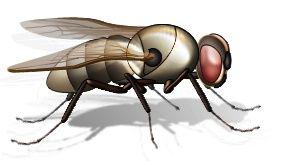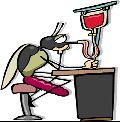Natural Solutions to Things That Bug You (58 page)
Read Natural Solutions to Things That Bug You Online
Authors: Myles Bader

Crop Residues
- Unwanted crop residues, such as peanut vines, discarded in piles during harvest are frequently very important sources of fly breeding. This material should be spread thinly for quick drying.
Hay and Grain
- Accumulations of hay where animals are fed in the fields decay rapidly when exposed to the elements and may produce flies in tremendous numbers. To prevent this source of fly breeding, cattle should be fed at a different place in the field each time so that accumulations of old hay do not occur. Spilled grain around feed troughs or storage bins likewise may provide the stable fly with a moist, favorable breeding medium and should be cleaned up immediately.
Animal Manures
- When handled properly manure need not breed stable flies at all. lt should not be allowed to accumulate for more than a week before spreading thinly on the fields, where quick drying eliminates stable fly breeding.
Stables
- The recent popularity of pleasure horses has created a staggering number of new fly breeding sources. However, proper care and management of waste feed and manure can greatly reduce or eliminate fly populations in these areas. Stalls should be cleaned of droppings daily and the manure spread thinly (not more than 1-2 inches deep). The choice of bedding is also very important. Hay or straw absorbs urine and decomposes rapidly and unless it is changed every few days will produce flies by the thousands. A far better material is wood shavings, which, when cleaned of manure daily and changed approximately every two weeks, does not normally breed flies.
Other Sources - Any pile of moist, decaying organic matter should be considered a potential source of stable flies that can cause serious damage to farm animals.
YELLOW FLY
 Yellow flies are biting flies and similar to the common mosquito. Females feed on blood to trigger egg production and both male and female yellow flies eat plant nectar and pollen for energy. Males do not bite and yellow flies are found extensively throughout Latin America and tropical regions of the United States.
Yellow flies are biting flies and similar to the common mosquito. Females feed on blood to trigger egg production and both male and female yellow flies eat plant nectar and pollen for energy. Males do not bite and yellow flies are found extensively throughout Latin America and tropical regions of the United States.
The true yellow fly is believed to have migrated into the United States through Mexico. Yellow flies prefer hot, humid weather; they do not like sunlight and are most active during the hours just before twilight. They are also attracted to water, where they lay their eggs, and are frequently found at the edges of forest lakes and streams.
Adults measure approximately one centimeter in length, with one pair of black front legs and two pair of yellow back legs. Their abdomens are yellow and furry.
Yellow fly eggs measure approximately 1/16-inch. Initially white, these eggs quickly darken and turn black, at which point they are commonly mistaken for feces. Larvae are semi-aquatic, feeding on decaying organic matter found on water banks.
They molt approximately 10 times before burrowing into the ground for winter. After emerging, they locate a dry location within which to pupate.
Female yellow flies are fierce biters. Traps may help reduce populations near gardens or swimming pools.

CHAPTER 11

MOSQUITOES
MOSQUITOES
KILL THOSE LITTLE BLOOD SUCKERS

 Luckily, only 50% of the mosquitoes worldwide suck human blood. The female mosquito needs the protein from human blood to develop her eggs and lay them. When they don’t get the blood meal they have to consume their own wing muscles. There are 2,500 different species of mosquitoes worldwide and they only weigh in at
Luckily, only 50% of the mosquitoes worldwide suck human blood. The female mosquito needs the protein from human blood to develop her eggs and lay them. When they don’t get the blood meal they have to consume their own wing muscles. There are 2,500 different species of mosquitoes worldwide and they only weigh in at
1/25,000
th
of an ounce. They are so light that they are able to walk on water. The mosquito saliva, which they leave when they bite you, is what causes the itching.
In the United States alone there are over 150 species of mosquito and most can mature from an egg in one to two weeks. Mosquitoes need water to reproduce and they can usually find some standing water in pets dishes, drainage ditches, fishponds, old tires, damp mulch, rain gutter lines, sewers, planters, leaks around spickets, etc. Mosquitoes like to live near your home and are smart enough to know that there are plenty of free meals there; you and your family.
 During the day they will seek shelter from the sun and are more active when it cools down or in a shady spot. They will never go too far from water. Getting rid of any location that has even the slightest amount of standing water should help to eliminate the problem. They don’t like windy condition and prefer still air areas. Using a fan in the home will keep them out as well.
During the day they will seek shelter from the sun and are more active when it cools down or in a shady spot. They will never go too far from water. Getting rid of any location that has even the slightest amount of standing water should help to eliminate the problem. They don’t like windy condition and prefer still air areas. Using a fan in the home will keep them out as well.
The female mosquito eats a blood meal and then lays an egg on the surface of water. The water must be still so keep this in mind regarding mosquitoes on your property. If you have any standing water and there are mosquitoes in the neighborhood you will have eggs hatching in your backyard. They prefer very shallow water so it doesn’t take much to make them happy. They will feed on bacteria in the water after they hatch then they will turn into pupae. It only takes several days for mosquitoes to turn into an adult and go looking for you.
It only takes 1 pint of water to nurture 500 mosquito larvae.
Your best protection against mosquitoes is to be sure that they do not have a point of entry into your home. Be sure and seal off any openings and especially holes in screens.
Types of Mosquitoes: Aedes, Anopheles, and Culex
There are approximately 2,700 species of mosquito in the world; the three most significant genera are the Aedes, Anopheles, and Culex, as these types of mosquitoes are responsible for transmitting various diseases that are hazardous to mankind.
Since mosquitoes can be a pest both indoors and outdoors, the information and identification will be found in both books.
ASIAN TIGER MOSQUITO (AEDES)
 The Asian tiger mosquito (Aedes Mosquito) is one of the most dangerous types of mosquito, the Aedes, as it is more commonly known, feeds on the blood of humans. However, only the female mosquito bites. It transmits among humans diseases such as yellow fever and dengue fever and can also cause lymphatic filariasis, an illness that can trigger elephantiasis in certain cases.
The Asian tiger mosquito (Aedes Mosquito) is one of the most dangerous types of mosquito, the Aedes, as it is more commonly known, feeds on the blood of humans. However, only the female mosquito bites. It transmits among humans diseases such as yellow fever and dengue fever and can also cause lymphatic filariasis, an illness that can trigger elephantiasis in certain cases.
Most species of Aedes can be found in the tropical and subtropical zones of the world. Recently, the genus has been discovered in more temperate regions, and its presence can now be anticipated on every continent except Antarctica. The female Aedes mosquito lays its eggs on the surface of water; adulthood is reached within approximately six to seven days.
